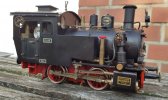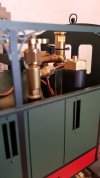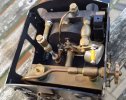You are using an out of date browser. It may not display this or other websites correctly.
You should upgrade or use an alternative browser.
You should upgrade or use an alternative browser.
Regner Else
- Thread starter Tropic Blunder1
- Start date
Trainman 864
Registered
Just to add my 2d worth - without trying to prolong the controversy ....Glad you raised the rainwater issue again Jimmy, I have worries about this on reflection. Acidity in the rain may not be the best thing to introduce to live steam. For my part I reckon having expended near or in many cases well over a grand UK for a live steam engine getting the right water should be a priority. A dehumidifier is really the only option to be sure, chemists so called de humidified has doubtful properties and certainly any tapwater may have chalk or other chemicals to keep it drinkable even in a soft water area.
Distilled water - changes it's ph from the moment it's made by the adsorption of CO2 if exposed to the atmosphere.
Dehumidifier water - needs filtration and can be acidic.
Rainwater - needs filtration and can be acidic, especially if the wind has been blowing from the industrial areas of N. europe.
Tumble dryer - can have lint - needs filtration.
Tap water - even soft water can cause eventual scaling.
Fridge water - needs filtration.
Sea water - causes dezincification and scaling - (just kidding ....
So that leaves - with the best balance of pros and cons and convienience ....
Deionized water - with 5% tap water added to quench it's insatiable desire to claw back it's lost ions.
Last edited:
Ok interesting, but can you say why water from a Dehumidifier needs to be filtered please?Just to add my 2d worth - without trying to prolong the controversy ....
Distilled water - changes it's ph from the moment it's made by the adsorption of CO2 if exposed to the atmosphere.
Dehumidifier water - needs filtration and can be acidic.
Rainwater - needs filtration and can be acidic, especially if the wind has been blowing from the industrial areas of N. europe.
Tumble dryer - can have lint - needs filtration.
Tap water - even soft water can cause eventual scaling.
Fridge water - needs filtration.
Sea water - causes dezincification and scaling - (just kidding ....)
So that leaves - with the best balance of pros and cons and convienience ....
Deionized water - with 5% tap water added to quench it's insatiable desire to claw back it's lost ions.
Trainman 864
Registered
Ok interesting, but can you say why water from a Dehumidifier needs to be filtered please?
OK - I should have said - 'may need to be filtered' ....
Most dehumidifiers of either the refridgeration or adsorbtion/absorbtion type have a relatively coarse filter on the air inlet to reduce the risk of obstructing the air passages within the device. There is no need for a fine filter as most of the airborne dust (including pathogens and allergens) will be entrained in the water condensing on the refigerant evaporator in a refrigerant dehumidifier - and on the water condenser in a desicant drum dehumidifier.
These contaminants in the water are of no consequence if you are using the device as a dehumidifier, in fact their removal has the benefit of improving the quality of the dried air - but if you want to use the waste water then you might want to consider filtering it.
The reality is of course, in most domestic applications, the contamination of the waste water is so low as to not be worth worrying about when using it for boiler feed water.
Last edited:
For the sake of an extra few minutes and a coffee filter, it's probably worth itThese contaminants in the water are of no consequence if you are using the device as a dehumidifier, in fact their removal has the benefit of improving the quality of the dried air - but if you want to use the waste water then you might want to consider filtering it.
Fred2179G
Registered
Well, over this side of the pond we can get "steam distilled water" in (US) gallon jugs for $1 in the local supermarket. Can't beat that for convenience. (Why don't they sell them in the UK? The water is used for steam irons, etc.)So that leaves - with the best balance of pros and cons and convienience ....
Deionized water - with 5% tap water added to quench it's insatiable desire to claw back it's lost ions.
JimmyB
Now retired - trains and fishing
First, I always filter my water what ever the source. Second deionised water I was told is a big No No, as the chemistry causes the ionisation in the vessel to deionise to match the contents eventually weakening the structure.Just to add my 2d worth - without trying to prolong the controversy ....
Distilled water - changes it's ph from the moment it's made by the adsorption of CO2 if exposed to the atmosphere.
Dehumidifier water - needs filtration and can be acidic.
Rainwater - needs filtration and can be acidic, especially if the wind has been blowing from the industrial areas of N. europe.
Tumble dryer - can have lint - needs filtration.
Tap water - even soft water can cause eventual scaling.
Fridge water - needs filtration.
Sea water - causes dezincification and scaling - (just kidding ....)
So that leaves - with the best balance of pros and cons and convienience ....
Deionized water - with 5% tap water added to quench it's insatiable desire to claw back it's lost ions.
Trainman 864
Registered
See the last line of my post #43 above ....................... Second deionised water I was told is a big No No, as the chemistry causes the ionisation in the vessel to deionise to match the contents eventually weakening the structure.
ol_hogger
Registered
This thread seems to have trickled away.
My Else is similar, quite.

Note the brass standpipe which is the water refill valve. There is a smaller version available which could be fitted to the steam manifold (if you don't have the whistle) or to the sightglass like in the Paul tram locomotive.

Else was Regner's only 1 gauge loco. Rather, as mentioned earlier in this thread a variant to the more popular Emma and Frieda models. They put in a little more detail, e.g. boiler top sandbox, more refined dome casting, dummy pump and generator. Plus functional brake gear. When I received it, Else was fully RC equipped to accomplish that - albeit with an obsolete system and the control missing.

The cab arrangement follows standard practice. The sightglass is the older narrow type, you may wish to descale it - or order the curent wider spare for replacement. The glass tube can readily be removed to be soaked in vinegar, citrus juice or coca cola until clear again. I even did it with the lower corner fitting (for a few minutes only) because it was almost plugged. Once you have got that one out it is a good opportunity for a boiler wash out (strictly use water here, NO descaler!).

And yes, water: Regner's instructions say: distilled with 5 % tap water with respect to the brass boiler so as to avoid ion scavenging.
My Else is similar, quite.

Note the brass standpipe which is the water refill valve. There is a smaller version available which could be fitted to the steam manifold (if you don't have the whistle) or to the sightglass like in the Paul tram locomotive.

Else was Regner's only 1 gauge loco. Rather, as mentioned earlier in this thread a variant to the more popular Emma and Frieda models. They put in a little more detail, e.g. boiler top sandbox, more refined dome casting, dummy pump and generator. Plus functional brake gear. When I received it, Else was fully RC equipped to accomplish that - albeit with an obsolete system and the control missing.

The cab arrangement follows standard practice. The sightglass is the older narrow type, you may wish to descale it - or order the curent wider spare for replacement. The glass tube can readily be removed to be soaked in vinegar, citrus juice or coca cola until clear again. I even did it with the lower corner fitting (for a few minutes only) because it was almost plugged. Once you have got that one out it is a good opportunity for a boiler wash out (strictly use water here, NO descaler!).

And yes, water: Regner's instructions say: distilled with 5 % tap water with respect to the brass boiler so as to avoid ion scavenging.
I thought it was de-ionised water that needed 5% tapwater, not distilled?distilled with 5 % tap water
Fred2179G
Registered
Only Regner wants you to add tap-water, as they use brass for the boiler. Distilled water is preferred over de-ionized water in any steamer.I thought it was de-ionised water that needed 5% tapwater, not distilled?
Greg Elmassian
Guest
Water wants to ionize... period.... distilled water really tries to attract/create ions. Many manufacturers that have appliances with boilers (high end espresso machines that have steam boilers) specifically invalidate the warranty if you use distilled water, it will erode the soldered connections... the common thought is that the purer the better with water, and that is fine unless you put it in something that will give up ions.
So, it really depends on the construction of the boiler, specifically how it was soldered together.
de-ionized water still has some ionization, so in these cases will not as aggressively etch the soldered connections.
But again, there will always be people who have a lifetime of success with distilled...
This is like the thread of what is the best way to lay track... never ending.
Greg
So, it really depends on the construction of the boiler, specifically how it was soldered together.
de-ionized water still has some ionization, so in these cases will not as aggressively etch the soldered connections.
But again, there will always be people who have a lifetime of success with distilled...
This is like the thread of what is the best way to lay track... never ending.
Greg
Tropic Blunder1
Jake
removed
Last edited:
JimmyB
Now retired - trains and fishing
I think you may need to advertise this in the "For Sale" section, along with the appropriate requirementsHi all the Else is for sale. I'm asking about $1000 Aud but happy for offers. PM for more details
